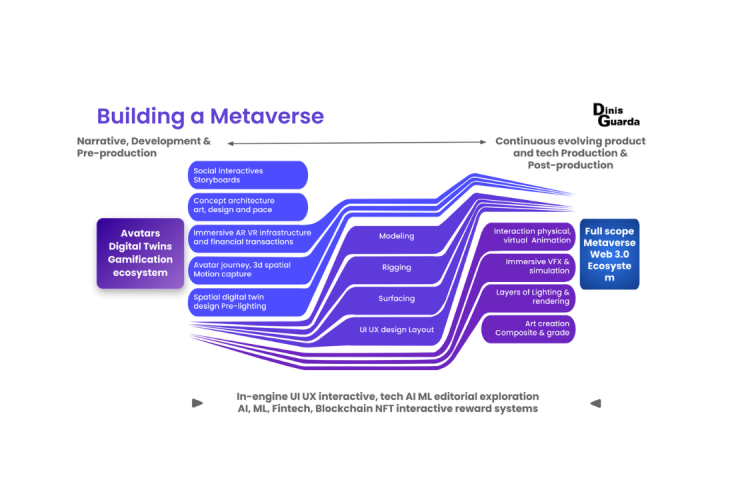Infographic: How To Build A Metaverse

Categories :
An immersive, near-to-reality trip to the Bahamas on a metaversive cruise, or exploring a virtual art exhibition at a metaversive gallery. These experiences are already in the mainstream. But what does it take to build a metaverse? Find it out in this infographic about how to build a metaverse.
As the world explores newer use cases of the metaverse, an ever-existing, online, three-dimensional, simulation of the real (physical) world, Metaverse is reshaping itself every day with Web 3.0 at its foundation and a permutation of multiple other elements.
Although it is complex at its base since multiple technologies play a role in this virtual world, the construction of a Metaverse must take into account the following principles:
Conceptualising avatars, digital twins, and gamification ecosystem
The foremost step here is to create a social interactive storyboard. Nothing beats a structured and appealing storyline. This requires exhaustive brainstorming sessions to build a gripping narrative.
It is imperative that the concept architecture and infrastructure align with the narrative. This is the stage where a storyteller can decide how to make the concept engaging for the audience. Decision-making and in-app purchases are some of the features to ensure participation from the audience. Therefore, making room for immersive AR VR infrastructure and creating a gateway for financial transactions are some of the elements critical during the pre-production stage.
Scheming the colour palette, designing the language and mood of the scene, and building perceptions using multiple senses (visual, auditory, etc.) are also some of the additional things a creator can plan for.
An interactive and safe UI/UX experience
AI and Machine Learning are the two of the top technologies that are powering the metaverse to create avatars and digital twins, the simulations of ourselves, our cities, and infrastructure, as close to reality as possible. This is very much like the characters we control in our games, socializing, learning, and working in the metaverse.
Real-life images, 3D spatial motion capture, and recordings can be weaved together to narrate the avatar journey through the storyline. Modelling, rigging, and surfacing techniques provide the frameworks, basic and advanced, that are close to reality when complemented with real-time data.
After carving out the scene, the next step is to design a layout that enhances an overall user experience. This encompasses creating an interactive space for users and limiting any toxicity and negative behaviour like bullying. Introducing reward systems, NFT alternatives, and fintech ways are some ways that encourage the users to participate in the metaverse and make a safe and growing community.
Full scope Metaverse Web 3.0 ecosystem
Now that the overall design and architecture of the metaverse are ready, it needs a few more finishing layers of rendering and art to make it completely immersive. Immersive Visual effects (or VFX) enhance the gaming and visual experience with better animations, simulating it closer to real-time. Layer it with better sound and lighting, and this piece of art is composite and ready to immerse the user into a world that is a digital twin of the real world.
Ensuring a safe and reliable metaverse future
A journey from narrative development & pre-production to continuously evolving product and tech production & post-production, building a metaverse is a time-consuming and skill-intensive process that utilizes a few of the finest technologies today. Nevertheless, with blockchain at its foundation, the metaverse is quite a powerful and reliable decentralized virtual space that promises to evolve in its degree of immersion.

Dinis Guarda is the founder and chief vision architect for citiesabc.com and CEOCreatorAuthor of freedomxcom. He has before created the platforms openbusinesscouncil.org, fashionabc.org, intelligenthq.com, hedgethink.com, tradersdna.com and and IP technologies blocksdna.com, lifesdna.com, iDNA and indexDNA.
With 20+ years experience in international business and digital transformation Dinis Guarda has been a Lecturer and guest Speaker in international business schools such as: Cambridge, Kings College, Copenhagen Business School, INSEEC, Monaco University among others. Dinis is the author of various books. His upcoming book, titled 4IR Magna Carta Cities ABC: A tech AI blockchain 4IR Smart Cities Data Research Charter of Liberties for our humanity is due to be published in 2020. Before that, he has published “4IR AI Blockchain Fintech IoT Reinventing a Nation“, “How Businesses and Governments can Prosper with Fintech, Blockchain and AI?”, also “Blockchain, AI and Crypto Economics – The Next Tsunami?” among others. He was responsbile for over 20 books/ebooks/magazines published in various languages.
Dinis is a serial entrepreneur and CEO / chairman of the companies ztudium / techabc / open business platform. Dinis is involved as a strategist, board member and advisor with the payments, lifestyle, blockchain reward community app Glance technologies, for whom he built the blockchain messaging / payment / loyalty software Blockimpact, the seminal Hyperloop Transportations project, Kora, and blockchain cybersecurity Privus.
He is listed in various global fintech, blockchain, AI, social media industry top lists as an influencer in position top 10/20 within 100 rankings: such as Top People In Blockchain | Cointelegraph and https://cryptoweekly.co/100/ .
Between 2014 and 2015 he was involved in creating a fabbanking.com a digital bank between Asia and Africa as Chief Commercial Officer and Marketing Officer responsible for all legal, tech and business development. Between 2009 and 2010 he was the founder of one of the world first fintech, social trading platforms tradingfloor.com for Saxo Bank. More about him here https://www.openbusinesscouncil.org/wiki/dinis-guarda/









